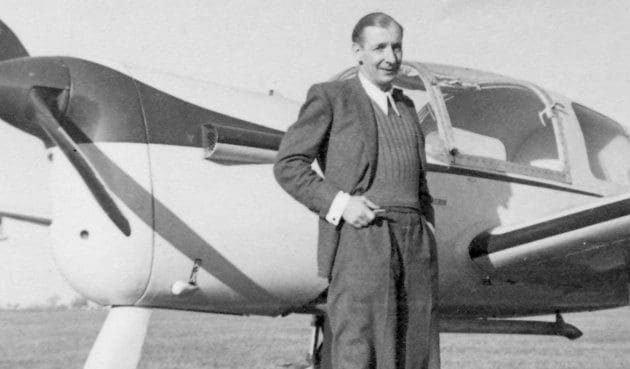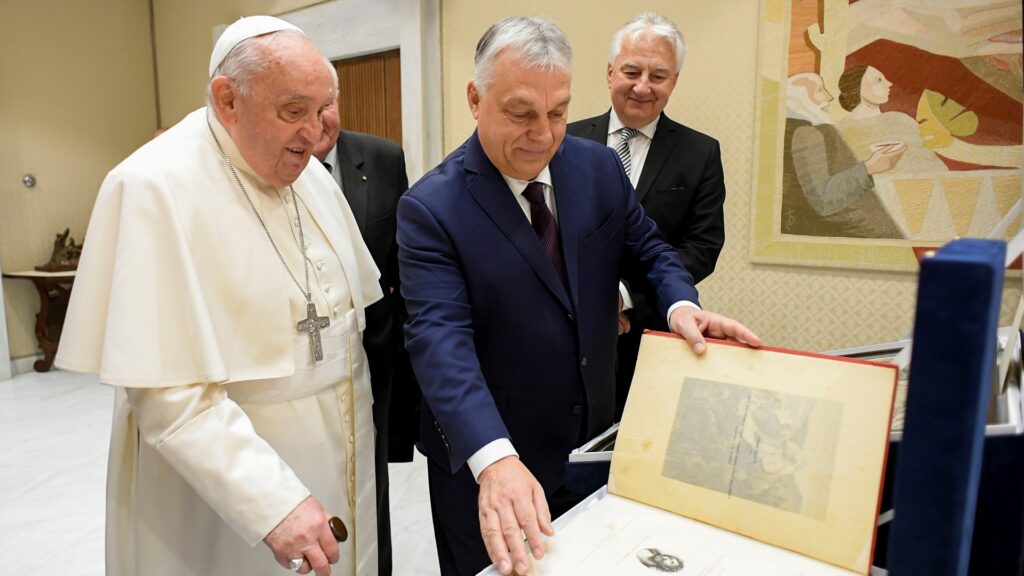More than a decade has passed since the movie The English Patient scooped up nine Oscars at the Academy Awards. The film’s main protagonist is the Hungarian desert explorer László Almásy, whose life’s work remained clouded in obscurity for decades in his own homeland. His name was even omitted from encyclopaedias, as if the editors had wanted to remove all trace of his achievements. The Oscar-winning movie, however, turned him into one of the best-known Hungarians on the planet, with his name featuring prominently in the media. The film raised numerous intriguing questions: Who was this mysterious person looking for happiness so far from home, in the barren, sandy world of the Libyan Desert? How did he arrange his expeditions to this desolate location? What did he achieve there? What secret missions did he carry out in Africa during the Second World War? What were his intentions? Where and how did he die?
From Bernstein to Eastbourne
The apple does not fall far from its tree, as the old saying goes. The family of György Almásy, a landowner, renowned ornithologist and Asian explorer, was blessed with a joyful event on 22 August 1895, when Ilona Pittoni gave birth to her second-born son. The arrival of László Ede Almásy was celebrated in Borostyánkő (today Bernstein, in Burgenland, Austria), behind the thick stone walls of the eyrie-like castle overlooking the village. The family had only moved to their new home three years previously, in 1892. Originally, their estates had been located near Zsadány and Törökszentmiklós. The Almásy family had belonged to the country’s prominent nobility since the seventeenth century. Incidentally, another of its members, Pál Almásy, was the Speaker of the House of Representatives who announced the Hungarian Declaration of Independence in the Great Reformed Church of Debrecen on 14 April 1849.
The grandfather, Eduárd Almásy, who purchased the property in Borostyánkő, was an open-minded, well-travelled man. He was fascinated by geographical exploration and new discoveries. Some five hundred of the volumes in his well-stocked library of more than five thousand books were about geography, astronomy, meteorology, and geology. He was a keen collector of travelogues, regularly bought the most up-to-date maps and atlases, and subscribed to German geographical journals. He was a founding member of the Hungarian Geographical Society, established in 1872. His son, György Almásy, graduated from law school, but felt no affinity for the work of solicitors and advocates. Instead, he lived off the income from the estate and its farm. However, he also inherited his father’s interest in the natural sciences. He went on several major expeditions in Asia, taking the young geographer Gyula Prinz with him on a journey to the Tian-Shan Mountains in 1906.
As a child, György Almásy’s son László, or ‘Master Laci’, could often be found in the dimly lit library, reading in a comfy chair among the yellowing atlases. Thus, it was in Borostyánkő that the world first started to open up for him. As a student at the Benedictine grammar school in Kőszeg, he started to show an interest in the migration patterns of birds, and it was here that his yearning to fly was born. As a small boy, he accompanied his father on expeditions to Dobruja and the Danube Delta, and later to Central Asia, returning home from these exotic climes with several cartloads of zoological specimens. In his youth, he saw how much work was required to prepare for an expedition. For László Almásy, the process of becoming an explorer began in his parents’ house, the castle in Borostyánkő. He was greatly influenced by the writings of the renowned ornithologist István Chernel, which he read often.
He attended secondary school in Graz, but had to leave amid scandal when, having set off late from home, he ran over the school’s principal on his ‘velocipede’ at the school gate. Another memorable adventure was when he tested his own homemade aircraft, pushing off from the edge of a steep-sided stone quarry, only to immediately plummet several tens of metres to the ground. He survived the accident with minor injuries, in no way discouraged from his lifelong passion for flight. He continued his secondary education in Eastbourne, England. It was during his years as a student in England that he became acquainted with the British culture and way of life, acquiring an almost native proficiency in the English language. He formed a connection with the scouting movement, whose standards and rules would have a profound impact on his later life. The books of the famous British explorer of Africa, Frederick Selous were what sparked his interest in the ‘Dark Continent’. The manners and way of thinking that he learned during his time at school in Eastbourne would later help him earn the trust of both the British and the Egyptians, as well as financial support for his research in the Sahara.
In the king’s service
During the First World War, László served on the Russian and later the Italian front. He was involved in several risky reconnaissance sorties along the Dniester River. After the war, he participated in the attempt by Charles IV of Hungary (Charles I of Austria) to retake the throne, also known as the ‘royal coup d’état’. On 5 April 1921, he and the Bishop János Mikes escorted the Habsburg ruler to the border. Almásy’s purported title of Count dates back to this period, because those present remembered that during his stay Charles IV consistently addressed Almásy as ‘Count’. Almásy refers to this epithet in a letter addressed to László Tasnádi, chairman of the University of Technology Flying Club, written in Cairo on 21 July 1939:
‘Be assured that I have defended myself enough against the rank that has been so liberally dealt out to me. For your personal information, allow me to explain this onerous situation: when His Majesty King Charles IV of Hungary ascended to the throne, my grandfather was invited, as trustee of the Almásy estate in Zsadány and Törökszentmiklós, to petition for the other branches of our family to be granted noble rank. His Majesty signed the petition in 1917, but since my grandfather had passed away in the meantime, my elder brother should have arranged for its countersigning by the Royal Ministerial Council. Due to the war, my brother did not do this, and thus the document languishes incomplete in our archive to this day. When His Majesty stayed in Szombathely in 1921, I was assigned to him as adjutant, during which time the King—remembering the petition that he had signed—consistently addressed me as Count. This practice continued in legitimist circles thereafter, and occasionally in the press as well. You can imagine how often my brother and I have to protest against the title of Count, upon which many other people insist, however, in order to satisfy their own vanity.’
Many of the aristocrats in Almásy’s circle held titles, and he was at ease in the company of nobles. His ownership of the Borostyánkőcastle and estate also fed the false belief that he, too, was a count. It was a little-known fact, however, that the Almásy estate was held in a trust in the name of László’s elder brother János. The title of Count does not feature on Almásy’s official documents and certificates, and nor was it displayed on any of his published works, books, or articles.
Enchanted by the desert
Almásy, who had also gained a reputation as a racing driver, set off in a Steyr car from Alexandria along the Nile—in the company of Antal Esterházy—to Khartoum, before crossing the Nubian and Berber deserts. The undertaking caused a sensation. The Steyr factory in Austria appointed Almásy head of the firm’s representation in Cairo, in the hope of opening up a market for the Austrian vehicle marque in Egypt. The following year, Almásy made a perilous journey in the Eastern Sahara, travelling 700 km through the dunes to Abu Mohar. He went on several hunting expeditions in the Libyan Desert. On one of these excursions, he hunted with the acclaimed writer Zsigmond Széchenyi, who recorded their experiences in his hunting journal entitled Hengergő homok (Rolling Sand); although he was not permitted to name Almásy in the later, 1964 edition of the work published by Hungary’s main literary publishing house, Szépirodalmi Könyvkiadó.
Almásy met Prince Kemal el Dine Hussein,
and also made the acquaintance of King Fuad and numerous other members of Egypt’s ruling house. As an accomplished networker, he won over patrons from the wealthiest circles in Egypt. Kemal el Dine Hussein funded his expeditions generously because he recognized that Almásy’s activities furthered the geographical exploration of Egypt, and knew that the data collected by Almásy in the unknown interior of the Sahara were of great strategic importance. The 1930s proved fateful for Almásy. After a lucky escape in an air crash near Syria with Count Nándor Zichy, he returned to Egypt. On 1 May 1932, he and his Scottish companion, Wing Commander Penderel, spotted the long-lost oasis of Zarzura from the cockpit of their British-made Tiger Moth plane.
The discovery of the Wadi Abd el Malik, the northern main valley of the Gilf Kebir sandstone plateau, was a global sensation. In February of the following year, Almásy returned to the Gilf Kebir region with a major expedition. With the help of the Austrian journalist Richard Bermann, he managed to secure financial backing from the US film studio Universal. One member of this expedition was László Kádár, a lecturer and future renowned professor of geography at the University of Debrecen.
Swimmers in the desert
Almásy’s 1933 expedition filled in the last white patch of the Libyan Desert on the atlas. Zerzura—typically for a rain-fed oasis—was entirely uninhabited due to the lack of water. László Almásy was the first European explorer to conduct a detailed geographical survey of this, one of the most deserted and inaccessible corners of the Sahara. Exploring the sheer-sided rock gullies, or wadis, of Gilf Kebir in the April heat was physically demanding for the members of the expedition. Almásy’s team came across ancient pictures of animals and people in caves that had formed in the sandstone rocks of the Gilf Kebir valley, surrounded by picturesque mountains. In the Wadi Sura—the ‘Valley of Pictures’— the red images of ostriches and palm trees painted by Neolithic people on the walls of their cliff caves show that greenery once flourished where today there are only dry tufts of grass. Almásy’s attention was drawn to the most intriguing picture, showing people swimming, and he preserved them in watercolour in his sketchbook. For swimming, you need water, and today in this bare corner of the Sahara there is neither water nor greenery! The nearest waterway where swimming is possible is the Nile, a thousand kilometres or so to the east of the Wadi Sura. But whoever made these paintings must have seen people swimming, so presumably there were temporary or permanent bodies of water, suitable for swimming, in the area. (During an expedition organized by the Hungarian Geographical Museum in 1993, with the participation of geography professors Dr Gyula Gábris and Dr József Szabó, and the photographer Péter Antall, we performed a detailed study of the terrain in this rocky place, but found no traces of a former lake, terrace remnants, or lake sediment.)
The animal pictures showing cattle, giraffes, gazelles, antelopes, and ostriches suggest a wetter climate, with nutrient-rich, probably savannah-like plant life. Who the cave artists were remains uncertain to this day. László Kádár believes that the desert peoples mentioned in the historical works of Herodotus, the Garamantes or the cave-dwelling Troglodytes, could have been the ones to depict what they saw in this way. It was in Wadi Sura that Almásy had his first taste of the thrill of discovering prehistoric artefacts. He resolved to study the unexplored oases of the Libyan Desert, Merga and Arcuna, and the Uweinat Mountains, from this perspective too. Almásy’s attention was drawn to the dry riverbeds, and he wrote about their origins in his report to the British Royal Geographical Society as follows:
‘Summer rains gradually reach Uweinat, Arkenut, El Biba and El Hamra Vadis, Vadi Abd El Malik and Talah Vadi. This rain falls for two or three months, twice or three times a week, usually in the evening and in the morning, often accompanied by storms and heavy rains. Such rainy periods continue for two or three years and then stop for a long time. The last rainfall reached Uweinat nine years ago.’
The rock caves that serve as a natural reservoir for the Sahara were hidden in the Uweinat Mountains bordering Sudan, Libya, and Egypt. The water from the springs in the granite caves of this stone wilderness was lifesaving in the arid heat. In the labyrinth of caves in the spherical granite formations of the rocky cauldron of Ain Dua, Almásy and his Arab assistant Sabr came across hundreds of pictures of people and animals. They discovered around 800 cave paintings. Similar images were found in Karkur Talh. The white, red, dark brown, and yellow animal figures, and the black human figures, are unique evidence of prehistoric culture. Almásy recorded the discovery as follows:
‘The human figures were always painted black and depicted with red hair and white feather ornaments on their heads. Their upper arms and ankles were adorned with white bracelets and ankle chains, and chains and white feathers hung from their hips. They carried quivers filled with feathered arrows, and small bows that ended in a cross at the bottom. With the help of the Italian Topographical Mission, soon after the first discoveries, we found another ten caves in the cliffs above Ain Dua, and in these a total of some 800 cave paintings, all painted on the ceilings of the individual caves.’
Almásy was the first to report on the Magyarab people,
whose ancestors—so legend has it—were abducted and taken from Hungary by the Turks. It was near Wadi Halfa, on one of the islands in the Nile, that he encountered representatives of the Magyarabs, who greeted him warmly as a relative. During my own expedition to Khartoum with Zsolt Cséke, in 2004, we met elderly Sudanese Magyarabs who had known Almásy personally. They said he had wanted to invite them to his home country, as a member of the scout brotherhood, but the British colonial authorities prohibited them from travelling at the last moment.
Rommel’s soldier in Africa
During the Second World War, Mussolini’s Italy was preparing for large-scale military operations in Libya. These ambitions, however, exceeded the Italians’ capabilities, and on 9 December 1940, the British Army, led by General Richard O’Connor, dealt a crushing defeat to the Italian forces that outnumbered them five to one. In February 1941, Hitler’s military leadership decided to assist their beleaguered ally. The newly appointed commander of Germany’s Afrika Korps was Erwin Rommel, known as a legendary hero to his adversaries as well as his own men. Almásy’s name was already familiar in the German-speaking world. By virtue of his book The Unknown Sahara, he was well known at the headquarters of the German intelligence service, the Abwehr. The Germans were aware that Almásy not only knew the Sahara extremely well, but also had excellent contacts in the Egyptian government. As a flying instructor, he had forged friendships with numerous Cairo dignitaries. He was a regular guest at the court of King Farouk, and was friends with Taher Pasha, Alaeddin Mouhtar Pasha, the Egyptian chief of staff, and El Masri Pasha. Besides these, he was also in contact with members of the anti-British young officers’ movement, Gamal Abdel Nasser, and Anwar el Sadat, Egypt’s future heads of state.
At the time, Almásy was serving in the Hungarian Air Force. The commander of the Hungarian Air Force, Lieutenant General Waldemár Kenessey—at the Germans’ request— seconded him to the German Army on 8 February 1941. This personal request for his secondment was highly prestigious, as the Germans had no shortage of manpower but needed an expert with an excellent knowledge of the desert.
The German Reich, with a population several times the size of Hungary’s, did not have a single expert with Almásy’s comprehensive knowledge of the Sahara. The Hungarian desert explorer donned a German uniform and received a German pay book; but he still displayed Hungarian insignia on his clothing. He was happy to take on the task, not least because he was keen to search for the lost army of the Persian king Cambyses, which had vanished in the sands of the Libyan Desert in the sixth century BC. Before leaving, he said to István Sterbetz over supper at the Sipos Inn in Budapest, ‘All I’m interested in doing out there is digging up Cambyses! Rommel will provide the petrol’.
His first mission allowed him to show off his unmatched aviation skills. After a few months of training, he had received his rating to fly Heinkel and Junkers aircraft. He is also credited with one of the most exciting secret missions of the Second World War, Operation Salam. In this operation, planned by the Abwehr, he delivered the German intelligence agents Johann Eppler and Hans Gerd Sandstede behind British lines along some 5,600 km of uninhabited, waterless desert roads. The participants in the journey, made with two Ford de Luxe trucks and two Ford passenger cars, were in mortal danger several times. The success of the mission—carried out in the May heat of around 50 °C—was nothing short of miraculous. The British had a squad of five hundred men led by the famous desert explorer Ralph Bagnold out searching for the German reconnaissance unit, after managing to break their cyphers and thus decode their radio messages.
Almásy overcame the challenges of the desert with matchless inventiveness. In the southern approach to Gilf Kebir, he topped up his dwindling fuel supply from the full tanks of unattended British vehicles. He then unscrewed the filler caps of the vehicles, and sprinkled fine-grained sand into their oil tanks, taking care not to leave a single grain in the area around the filler cap as a sign of his tampering. He was also careful to sprinkle a different amount of sand into each tank, so that the engines would not all stop at the same time. One can only imagine the dismay that the British must have felt when their vehicles became useless, one at a time, some 10 to 20 km into their journey.
The participants in Operation Salam were close to dying from thirst, when the Hungarian desert explorer saved them from certain death. At the southern perimeter of Gilf Kebir, they realized that their depleted stock of water would not hold out until the Nile Valley. Almásy, however, remembered that in 1932 he had set up an emergency water depot in tin cans concealed among the rocks at the entrance to the nearby Wadi Sura. He had personally sealed the eight Shell jerry cans, which he had brought with him from Cairo. This water supply had also saved the lives of Major Bagnold and his companions in 1935, when they had given up hope and were preparing to die. With their only car rendered useless by a broken axle, Bagnold’s party consumed four cans of water to stay alive for the eight days it took for the rescue expedition to find them. Bagnold had learned about the water depot from Almásy, who had established it for the purposes of his future explorations of caves in the area. When Almásy told his companions about this, they listened in disbelief, thinking that their commander was just trying to keep their spirits up. But he was telling the truth. Miraculously, after a brief search, they came across four undamaged water vessels. The four cans that had been used by Bagnold’s expedition were already rusted through. Almásy cautiously opened one of the containers. The water was warm but turned out to be clean. The ten-year-old water, carefully sealed in the cans, was still drinkable!
At the Kharga Oasis, Almásy bluffed his way through a British–Egyptian checkpoint to escape the British patrols that were searching for them. All units of the Long Range Desert Group were alerted, and Almásy evaded them with almost unbelievable aplomb by taking a route across the Aqaba Pass, which was believed to be impenetrable. He sent the two German intelligence agents Eppler and Sandstede on their way in Assiut, but they were later exposed in Cairo due to their opulent lifestyles and carelessness. Almásy’s unit, however, successfully completed its mission and returned to Gialo after a 5,600 km journey. Almásy described his African escapades in his book entitled With Rommel’s Army in Libya, taking care to include as little specific information as possible. The book later constituted one of the charges against him at the People’s Tribunal.
Rescuer of the persecuted
Almásy spent the dark period of 1944–1945 in Budapest. In November 1944, he gave refuge to several persecuted Jews in his apartment at Horthy Miklós Street (today Bartók Béla Street). At great personal risk, he hid and fed György Fuchs, son of the Olympic champion, Jenő Fuchs. Purely altruistically, without any financial motive, he helped those whose lives were in peril solely because of their ethnicity. Several times he appeared in German military uniform with a major’s rank insignia and medals on his chest to send away the Arrow Cross party officials conducting raids on the building, who did not dare to defy Almásy, believing him to be a German officer.
According to his niece, Zita Gyömörei, in the autumn of 1944 Almásy hid a ten-year-old Jewish boy named Rubinstein in the Don Bosco Home of the Catholic Church in the town of Vác. The little boy survived the war with papers issued in the name of Antal Árkos, and later—with the help of relatives—made it to America. Several of the house’s residents owed their lives to Almásy’s courage. This fact was also discussed during the trial held at the People’s Tribunal.
Unfortunately, criminal proceedings in the post-war People’s Tribunals were dominated by emotions, not by facts. Almásy was arrested several times, and brutally abused by the political police. He did not deny his service under Rommel, but did not plead guilty to any war crimes—of which he was accused—either during the police interviews or in court. Finally, he was exonerated of the charges based on the testimony of the acclaimed orientalist Gyula Germanus, but he remained under threat of arrest. Political police investigators took him into custody again in January 1947. He was only able to secure his release with the help of his Egyptian friend, the cousin of Egypt’s King Farouk, Alaeddin Mouhtar Pasha. He lost his home and had no work or prospects. He could not stay in Borostyánkő, which was inside the Soviet-occupied zone of Austria at the time. He had to flee Europe. He spent the last years of his life in Egypt, where he rented a small flat in the Zamalek district of Cairo, supporting himself by giving flying lessons and car tours of the desert. He made several attempts to find traces of the lost army of Cambyses, which had once left Thebes for the Siwa Oasis but disappeared along with its treasures in the sands of the Libyan Desert.
The career of this remarkable individual, spanning half a century, was packed with surprises and secrets. However, the journey of the great racing driver, daring pilot, helpful scout, passionate hunter, astute businessman, committed expedition leader, tireless researcher, successful explorer, exceptional archaeologist, crafty reconnaissance agent, captivating storyteller, and tortured prisoner who stood trial at the People’s Tribunal, came to a prosaic end. Suffering from amoebic dysentery, he was admitted to the Wehrle Sanatorium in Salzburg, where he was operated on by Professor Viktor Wehrle himself; but an abscess formed in his liver which, together with other complications, proved fatal. After suffering in agony, László Almásy died in the Wehrle Sanatorium on 22 March 1951.








